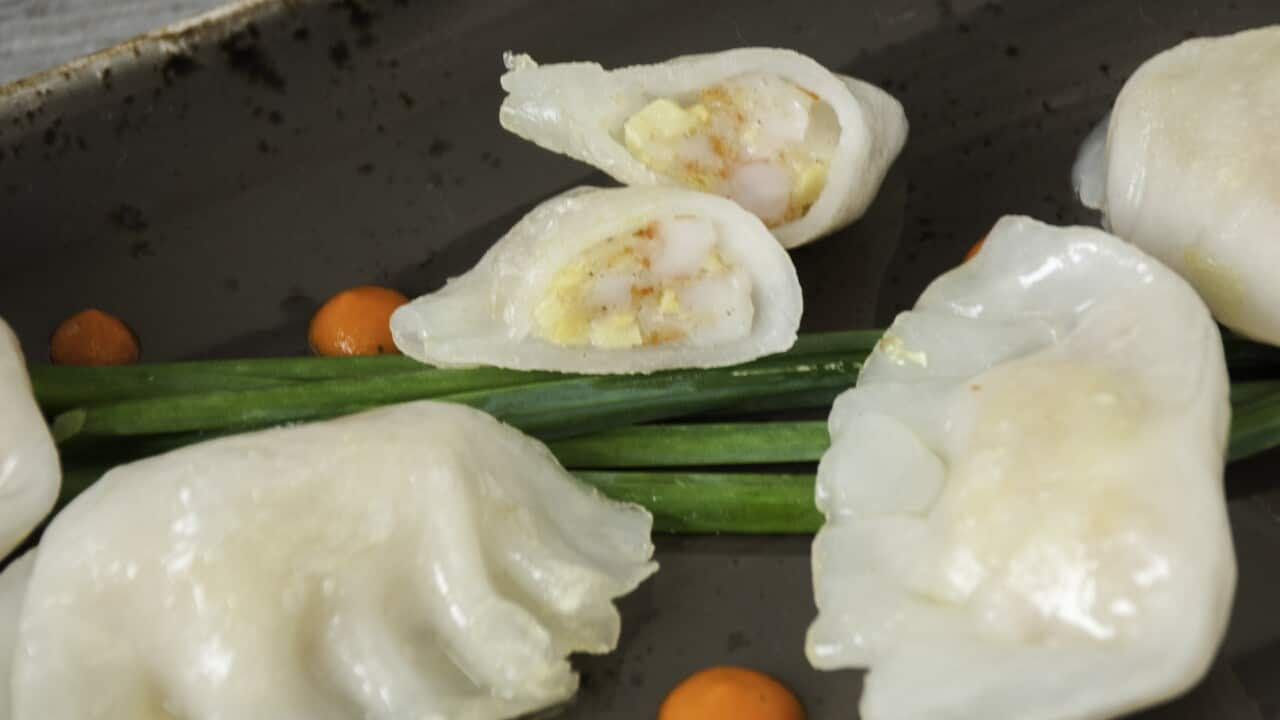Scrolling through my phone for evidence of Christmas, I find photos of hot pot at my aunt’s, and tong jyun [汤圆, glutinous rice balls] dated 22 December 2017 and 2018. The pearl-like orbs, purple, violet and white, catch my eye. Mum jokes that she had to force my brother and I to eat tong jyun when we were younger. “It’s not that I don’t like tong jyun,” I counter. “It’s more that I don’t love them.” Soft, chewy and somewhat bland, I did not understand the significance of this dessert until more recently.
Every year, Mum would make tong jyun, served in warm ginger syrup (sometimes pandan syrup), for dong zit [冬节, Winter Solstice Festival]. She mixed glutinous rice flour with water to form a soft dough and divided into three or four portions. One would be left white and the rest dyed: pink, green or yellow. My job was to roll the dough into small balls, the size of a two-dollar coin, for Mum to boil. I rarely had patience to make many. Fortunately, we only had to make enough for our family of four.
Soft, chewy and somewhat bland, I did not understand the significance of this dessert until more recently.
Dong zit, which translates to ‘winter festival’, falls on or around 22 December and is among the most important Chinese festivals. As the shortest day of the year, it marks a turning point. With darkness and cold giving way to light and warmth, it is a time for optimism, family gathering and worshipping ancestors. In ancient times, the festival also marked the first day of the new year. As such, some, especially the elderly, believe that everyone turns a year older on dong zit. Northern parts of China celebrate by eating savoury dumplings while tong jyun are eaten in the south.
Tong jyun are traditionally white or pink and unfilled. Nowadays, they can be bought all year round from the frozen section of Asian supermarkets around the world, filled with black sesame paste (the most common and my favourite), peanuts, red bean paste, yam paste and other flavours. The round shape of tong jyun and the bowls in which they are served, symbolise family togetherness, unity and harmony, particularly as tong jyun sounds like the word tyun jyun [团圆] which means reunion.
I reflect on this humble tradition, one I have taken for granted, being passed down generations, from China to Malaysia to Australia.
“Anyone can make tong jyun,” Mum says. “Even children!” She recalls making them with siblings, as her mother prepared a feast. Before the meal, they prayed to ancestors, placing three bowls of tong jyun on the family altar. Dad has similar memories with his family. The tong jyun we make today are smaller than those from their childhood, as Mum finds these easier to eat. She laughs at the memory of attempting to eat 25, in accordance with her age. Her paternal grandparents and father loved tong jyun; she and her mother less so. Nevertheless, Mum wanted to pass the tradition on to us and now, my cousin’s children. She considers making tong jyun a fun way to introduce Chinese culture to children as “it’s like playing with Play-Doh”. Last year, she dyed our tong jyun bright purple using a homemade plant dye.
My memories of helping to prepare yee sang and make kuih kapit for Lunar New Year, wrap zung in bamboo leaves for Dragon Boat Festival, and make pig-shaped biscuits for Mid-Autumn Festival are vivid. In contrast, making tong jyun is endearingly simple—all you need is flour and water. I reflect on this humble tradition, one I have taken for granted, being passed down generations, from China to Malaysia to Australia. (My Chinese-Australian friends celebrate dong zit to varying degrees; some not at all, some only as a child.)
As a writer, my instinct was to turn to literature for my lineage—Eileen Chang, Xiaolu Guo and so on. Tong jyun reminds me of my family’s love, all I have learnt from my mother and all I am still to learn. I hope we continue to make and eat tong jyun for decades to come.
Note: I have used Cantonese pronunciation and simplified Chinese characters. In Mandarin, 汤圆 is pronounced tang yuan, 冬至 dong zhi and 团圆 tuan yuan. Winter Solstice Festival is also known as 冬至, which translates to ‘the arrival of winter’ or ‘winter’s extreme’. This is pronounced dong zi in Cantonese and dong zhi in Mandarin.
This story is the first in a series titled A Festive Perspective, which showcases personal stories of food and culture during the festive season through varying multicultural lenses. You can read them all .









